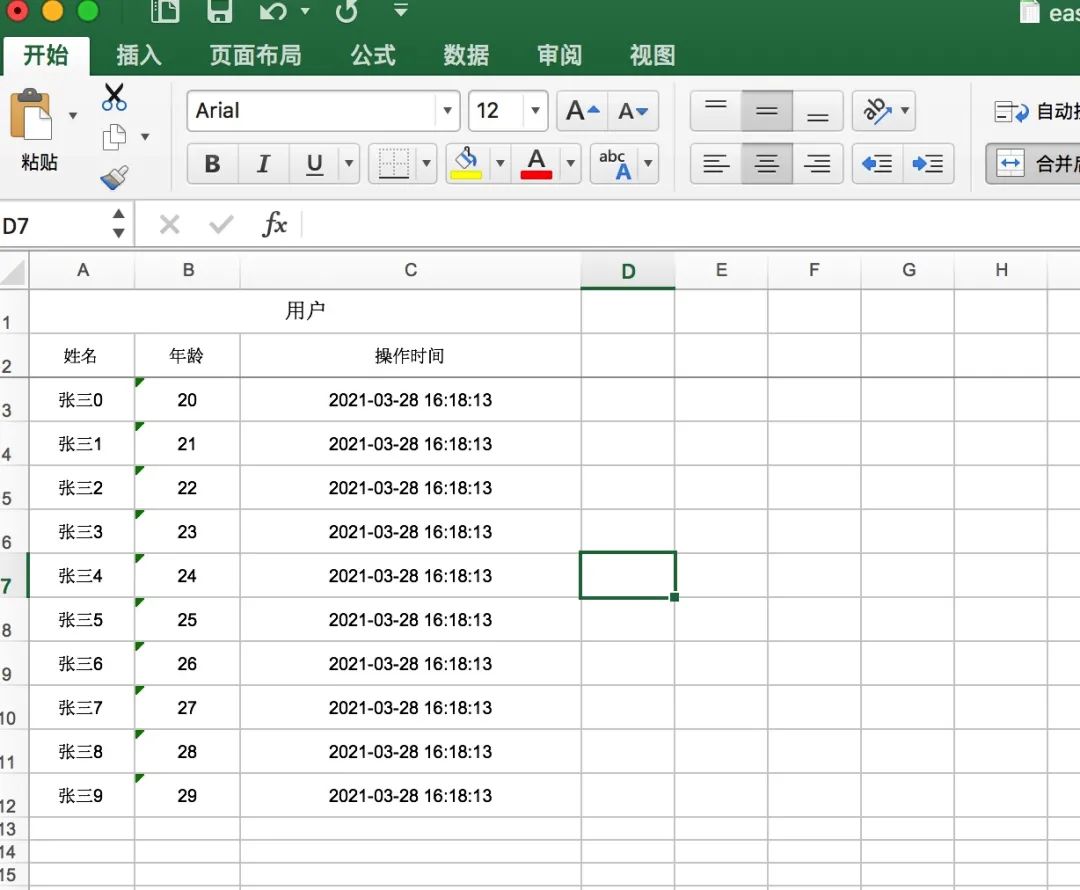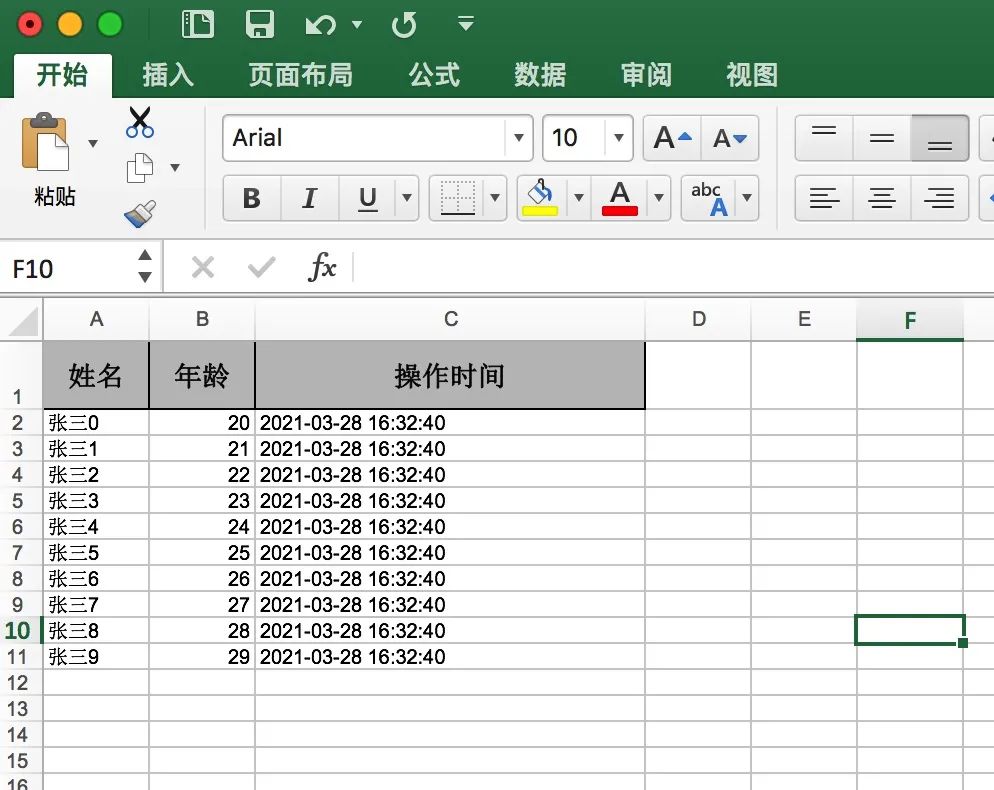一、介绍
在平时的业务系统开发中,少不了需要用到导出、导入excel功能,今天我们就一起来总结一下,如果你正为此需求感到困惑,那么阅读完本文,你一定会有所收获!
二、poi
大概在很久很久以前,微软的电子表格软件 Excel 以操作简单、存储数据直观方便,还支持打印报表,在诞生之初,可谓深得办公室里的白领青睐,极大的提升了工作的效率,不久之后,便成了办公室里的必备工具。
随着更多的新语言的崛起,例如我们所熟悉的 java,后来便有一些团队开始开发一套能与 Excel 软件无缝切换的操作工具!
这其中就有我们所熟悉的 apache 的 poi,其前身是 Jakarta 的 POI Project项目,之后将其开源给 apache 基金会!
当然,在java生态体系里面,能与Excel无缝衔接的第三方工具还有很多,因为 apache poi 在业界使用的最广泛,因此其他的工具不做过多介绍!
话不多说,直接开撸!
2.1、首先引入apache poi的依赖
<dependencies><!--xls(03)--><dependency><groupId>org.apache.poi</groupId><artifactId>poi</artifactId><version>4.1.2</version></dependency><!--xlsx(07)--><dependency><groupId>org.apache.poi</groupId><artifactId>poi-ooxml</artifactId><version>4.1.2</version></dependency><!--时间格式化工具--><dependency><groupId>joda-time</groupId><artifactId>joda-time</artifactId><version>2.10.6</version></dependency>
</dependencies>
2.2、导出excel
导出操作,即使用 Java 写出数据到 Excel 中,常见场景是将页面上的数据导出,这些数据可能是财务数据,也可能是商品数据,生成 Excel 后返回给用户下载文件。
在 poi 工具库中,导出 api 可以分三种方式
HSSF方式:这种方式导出的文件格式为office 2003专用格式,即
.xls,优点是导出数据速度快,但是最多65536行数据XSSF方式:这种方式导出的文件格式为office 2007专用格式,即
.xlsx,优点是导出的数据不受行数限制,缺点导出速度慢SXSSF方式:SXSSF 是 XSSF API的兼容流式扩展,主要解决当使用 XSSF 方式导出大数据量时,内存溢出的问题,支持导出大批量的excel数据
2.2.1、HSSF方式导出
HSSF方式,最多只支持65536条数据导出,超过这个条数会报错!
public class ExcelWrite2003Test {public static String PATH = "/Users/hello/Desktop/";public static void main(String[] args) throws Exception {//时间long begin = System.currentTimeMillis();//创建一个工作簿Workbook workbook = new HSSFWorkbook();//创建表Sheet sheet = workbook.createSheet();//写入数据for (int rowNumber = 0; rowNumber < 65536; rowNumber++) {//创建行Row row = sheet.createRow(rowNumber);for (int cellNumber = 0; cellNumber < 10; cellNumber++) {//创建列Cell cell = row.createCell(cellNumber);cell.setCellValue(cellNumber);}}System.out.println("over");FileOutputStream fileOutputStream = new FileOutputStream(PATH + "用户信息表2003BigData.xls");workbook.write(fileOutputStream);fileOutputStream.close();long end = System.currentTimeMillis();System.out.println((double) (end - begin) / 1000);//4.29s}
}
2.2.2、XSSF方式导出
XSSF方式支持大批量数据导出,所有的数据先写入内存再导出,容易出现内存溢出!
public class ExcelWrite2007Test {public static String PATH = "/Users/hello/Desktop/";public static void main(String[] args) throws Exception {//时间long begin = System.currentTimeMillis();//创建一个工作簿Workbook workbook = new XSSFWorkbook();//创建表Sheet sheet = workbook.createSheet();//写入数据for (int rowNumber = 0; rowNumber < 65537; rowNumber++) {Row row = sheet.createRow(rowNumber);for (int cellNumber = 0; cellNumber < 10; cellNumber++) {Cell cell = row.createCell(cellNumber);cell.setCellValue(cellNumber);}}System.out.println("over");FileOutputStream fileOutputStream = new FileOutputStream(PATH + "用户信息表2007BigData.xlsx");workbook.write(fileOutputStream);fileOutputStream.close();long end = System.currentTimeMillis();System.out.println((double) (end - begin) / 1000);//15.87s}
}
2.2.3、SXSSF方式导出
SXSSF方式是XSSF方式的一种延伸,主要特性是低内存,导出的时候,先将数据写入磁盘再导出,避免报内存不足,导致程序运行异常,缺点是运行很慢!
public class ExcelWriteSXSSFTest {public static String PATH = "/Users/hello/Desktop/";public static void main(String[] args) throws Exception {//时间long begin = System.currentTimeMillis();//创建一个工作簿Workbook workbook = new SXSSFWorkbook();//创建表Sheet sheet = workbook.createSheet();//写入数据for (int rowNumber = 0; rowNumber < 100000; rowNumber++) {Row row = sheet.createRow(rowNumber);for (int cellNumber = 0; cellNumber < 10; cellNumber++) {Cell cell = row.createCell(cellNumber);cell.setCellValue(cellNumber);}}System.out.println("over");FileOutputStream fileOutputStream = new FileOutputStream(PATH + "用户信息表2007BigDataS.xlsx");workbook.write(fileOutputStream);fileOutputStream.close();long end = System.currentTimeMillis();System.out.println((double) (end - begin) / 1000);//6.39s}
}
2.3、导入excel
导入操作,即将 excel 中的数据采用java工具库将其解析出来,进而将 excel 数据写入数据库!
同样,在 poi 工具库中,导入 api 也分三种方式,与上面的导出一一对应!
2.3.1、HSSF方式导入
public class ExcelRead2003Test {public static String PATH = "/Users/hello/Desktop/";public static void main(String[] args) throws Exception {//获取文件流FileInputStream inputStream = new FileInputStream(PATH + "用户信息表BigData.xls");//1.创建工作簿,使用excel能操作的这边都看看操作Workbook workbook = new HSSFWorkbook(inputStream);//2.得到表Sheet sheet = workbook.getSheetAt(0);//3.得到行Row row = sheet.getRow(0);//4.得到列Cell cell = row.getCell(0);getValue(cell);inputStream.close();}public static void getValue(Cell cell){//匹配类型数据if (cell != null) {CellType cellType = cell.getCellType();String cellValue = "";switch (cellType) {case STRING: //字符串System.out.print("[String类型]");cellValue = cell.getStringCellValue();break;case BOOLEAN: //布尔类型System.out.print("[boolean类型]");cellValue = String.valueOf(cell.getBooleanCellValue());break;case BLANK: //空System.out.print("[BLANK类型]");break;case NUMERIC: //数字(日期、普通数字)System.out.print("[NUMERIC类型]");if (HSSFDateUtil.isCellDateFormatted(cell)) { //日期System.out.print("[日期]");Date date = cell.getDateCellValue();cellValue = new DateTime(date).toString("yyyy-MM-dd");} else {//不是日期格式,防止数字过长System.out.print("[转换为字符串输出]");cell.setCellType(CellType.STRING);cellValue = cell.toString();}break;case ERROR:System.out.print("[数据类型错误]");break;}System.out.println(cellValue);}}
}2.3.2、XSSF方式导入
public class ExcelRead2007Test {public static String PATH = "/Users/hello/Desktop/";public static void main(String[] args) throws Exception {//获取文件流FileInputStream inputStream = new FileInputStream(PATH + "用户信息表2007BigData.xlsx");//1.创建工作簿,使用excel能操作的这边都看看操作Workbook workbook = new XSSFWorkbook(inputStream);//2.得到表Sheet sheet = workbook.getSheetAt(0);//3.得到行Row row = sheet.getRow(0);//4.得到列Cell cell = row.getCell(0);getValue(cell);inputStream.close();}public static void getValue(Cell cell){//匹配类型数据if (cell != null) {CellType cellType = cell.getCellType();String cellValue = "";switch (cellType) {case STRING: //字符串System.out.print("[String类型]");cellValue = cell.getStringCellValue();break;case BOOLEAN: //布尔类型System.out.print("[boolean类型]");cellValue = String.valueOf(cell.getBooleanCellValue());break;case BLANK: //空System.out.print("[BLANK类型]");break;case NUMERIC: //数字(日期、普通数字)System.out.print("[NUMERIC类型]");if (HSSFDateUtil.isCellDateFormatted(cell)) { //日期System.out.print("[日期]");Date date = cell.getDateCellValue();cellValue = new DateTime(date).toString("yyyy-MM-dd");} else {//不是日期格式,防止数字过长System.out.print("[转换为字符串输出]");cell.setCellType(CellType.STRING);cellValue = cell.toString();}break;case ERROR:System.out.print("[数据类型错误]");break;}System.out.println(cellValue);}}
}
2.3.3、SXSSF方式导入
public class ExcelReadSXSSFTest {public static String PATH = "/Users/hello/Desktop/";public static void main(String[] args) throws Exception {//获取文件流//1.创建工作簿,使用excel能操作的这边都看看操作OPCPackage opcPackage = OPCPackage.open(PATH + "用户信息表2007BigData.xlsx");XSSFReader xssfReader = new XSSFReader(opcPackage);StylesTable stylesTable = xssfReader.getStylesTable();ReadOnlySharedStringsTable sharedStringsTable = new ReadOnlySharedStringsTable(opcPackage);// 创建XMLReader,设置ContentHandlerXMLReader xmlReader = SAXHelper.newXMLReader();xmlReader.setContentHandler(new XSSFSheetXMLHandler(stylesTable, sharedStringsTable, new SimpleSheetContentsHandler(), false));// 解析每个Sheet数据Iterator<InputStream> sheetsData = xssfReader.getSheetsData();while (sheetsData.hasNext()) {try (InputStream inputStream = sheetsData.next();) {xmlReader.parse(new InputSource(inputStream));}}}/*** 内容处理器*/public static class SimpleSheetContentsHandler implements XSSFSheetXMLHandler.SheetContentsHandler {protected List<String> row;/*** A row with the (zero based) row number has started** @param rowNum*/@Overridepublic void startRow(int rowNum) {row = new ArrayList<>();}/*** A row with the (zero based) row number has ended** @param rowNum*/@Overridepublic void endRow(int rowNum) {if (row.isEmpty()) {return;}// 处理数据System.out.println(row.stream().collect(Collectors.joining(" ")));}/*** A cell, with the given formatted value (may be null),* and possibly a comment (may be null), was encountered** @param cellReference* @param formattedValue* @param comment*/@Overridepublic void cell(String cellReference, String formattedValue, XSSFComment comment) {row.add(formattedValue);}/*** A header or footer has been encountered** @param text* @param isHeader* @param tagName*/@Overridepublic void headerFooter(String text, boolean isHeader, String tagName) {}}}
三、easypoi
以前的以前,有个大佬程序员,跳到一家公司之后就和业务人员聊上了,这些业务员对excel报表有着许许多多的要求,比如想要一个报表,他的表头是一个多行表头,过几天之后,他想要给这些表头添加样式,比如关键的数据标红,再过几天,他想要再末尾添加一条合计的数据,等等!
起初还好,都是copy、copy,之后发现系统中出现大量的重复代码,于是有一天真的忍受不了了,采用注解搞定来搞定这些定制化成程度高的逻辑,将公共化抽离出来,于是诞生了 easypoi!
easypoi 的底层也是基于 apache poi 进行深度开发的,它主要的特点就是将更多重复的工作,全部简单化,避免编写重复的代码!
下面,我们就一起来了解一下这款高大上的开源工具:easypoi
3.1、首先添加依赖包
<dependencies><dependency><groupId>cn.afterturn</groupId><artifactId>easypoi-base</artifactId><version>4.1.0</version></dependency><dependency><groupId>cn.afterturn</groupId><artifactId>easypoi-web</artifactId><version>4.1.0</version></dependency><dependency><groupId>cn.afterturn</groupId><artifactId>easypoi-annotation</artifactId><version>4.1.0</version></dependency>
</dependencies>
3.2、采用注解导出导入
easypoi 最大的亮点就是基于注解实体类来导出、导入excel,使用起来非常简单!
首先,我们创建一个实体类UserEntity,其中@Excel注解表示导出文件的头部信息。
public class UserEntity {@Excel(name = "姓名")private String name;@Excel(name = "年龄")private int age;@Excel(name = "操作时间",format="yyyy-MM-dd HH:mm:ss", width = 20.0)private Date time;//set、get省略
}
接着,我们来编写导出服务!
public static void main(String[] args) throws Exception {List<UserEntity> dataList = new ArrayList<>();for (int i = 0; i < 10; i++) {UserEntity userEntity = new UserEntity();userEntity.setName("张三" + i);userEntity.setAge(20 + i);userEntity.setTime(new Date(System.currentTimeMillis() + i));dataList.add(userEntity);}//生成excel文档Workbook workbook = ExcelExportUtil.exportExcel(new ExportParams("用户","用户信息"),UserEntity.class, dataList);FileOutputStream fos = new FileOutputStream("/Users/hello/Documents/easypoi-user1.xls");workbook.write(fos);fos.close();
}
导出的文件预览如下:

对应的导入操作,也很简单,源码如下:
public static void main(String[] args) {ImportParams params = new ImportParams();params.setTitleRows(1);params.setHeadRows(1);long start = new Date().getTime();List<StudentEntity> list = ExcelImportUtil.importExcel(new File("/Users/hello/Documents/easypoi-user1.xls"),UserEntity.class, params);System.out.println(new Date().getTime() - start);System.out.println(JSONArray.toJSONString(list));
}
运行程序,输出结果如下:
[{"age":20,"name":"张三0","time":1616919493000},{"age":21,"name":"张三1","time":1616919493000},{"age":22,"name":"张三2","time":1616919493000},{"age":23,"name":"张三3","time":1616919493000},{"age":24,"name":"张三4","time":1616919493000},{"age":25,"name":"张三5","time":1616919493000},{"age":26,"name":"张三6","time":1616919493000},{"age":27,"name":"张三7","time":1616919493000},{"age":28,"name":"张三8","time":1616919493000},{"age":29,"name":"张三9","time":1616919493000}]
3.3、自定义数据结构导出导入
easypoi 同样也支持自定义数据结构导出导入excel。
自定义数据导出 excel
public static void main(String[] args) throws Exception {//封装表头List<ExcelExportEntity> entityList = new ArrayList<ExcelExportEntity>();entityList.add(new ExcelExportEntity("姓名", "name"));entityList.add(new ExcelExportEntity("年龄", "age"));ExcelExportEntity entityTime = new ExcelExportEntity("操作时间", "time");entityTime.setFormat("yyyy-MM-dd HH:mm:ss");entityTime.setWidth(20.0);entityList.add(entityTime);//封装数据体List<Map<String, Object>> dataList = new ArrayList<>();for (int i = 0; i < 10; i++) {Map<String, Object> userEntityMap = new HashMap<>();userEntityMap.put("name", "张三" + i);userEntityMap.put("age", 20 + i);userEntityMap.put("time", new Date(System.currentTimeMillis() + i));dataList.add(userEntityMap);}//生成excel文档Workbook workbook = ExcelExportUtil.exportExcel(new ExportParams("学生","用户信息"), entityList, dataList);FileOutputStream fos = new FileOutputStream("/Users/panzhi/Documents/easypoi-user2.xls");workbook.write(fos);fos.close();
}
导入 excel
public static void main(String[] args) {ImportParams params = new ImportParams();params.setTitleRows(1);params.setHeadRows(1);long start = new Date().getTime();List<Map<String, Object>> list = ExcelImportUtil.importExcel(new File("/Users/panzhi/Documents/easypoi-user2.xls"),Map.class, params);System.out.println(new Date().getTime() - start);System.out.println(JSONArray.toJSONString(list));
}
更多的 api 操作可以访问 Easypoi - 接口文档
四、easyexcel
easyexcel 是阿里巴巴开源的一款 excel 解析工具,底层逻辑也是基于 apache poi 进行二次开发的。不同的是,再读写数据的时候,采用 sax 模式一行一行解析,在并发量很大的情况下,依然能稳定运行!
下面,我们就一起来了解一下这款新起之秀!
4.1、首先添加依赖包
<dependencies><dependency><groupId>com.alibaba</groupId><artifactId>easyexcel</artifactId><version>2.2.6</version></dependency><!--常用工具库--><dependency><groupId>com.google.guava</groupId><artifactId>guava</artifactId><version>29.0-jre</version></dependency>
</dependencies>
4.2、采用注解导出导入
easyexcel 同样也支持采用注解方式进行导出、导入!
首先,我们创建一个实体类UserEntity,其中@ExcelProperty注解表示导出文件的头部信息。
public class UserEntity {@ExcelProperty(value = "姓名")private String name;@ExcelProperty(value = "年龄")private int age;@DateTimeFormat("yyyy-MM-dd HH:mm:ss")@ExcelProperty(value = "操作时间")private Date time;//set、get省略
}
接着,我们来编写导出服务!
public static void main(String[] args) {List<UserEntity> dataList = new ArrayList<>();for (int i = 0; i < 10; i++) {UserEntity userEntity = new UserEntity();userEntity.setName("张三" + i);userEntity.setAge(20 + i);userEntity.setTime(new Date(System.currentTimeMillis() + i));dataList.add(userEntity);}EasyExcel.write("/Users/hello/Documents/easyexcel-user1.xls", UserEntity.class).sheet("用户信息").doWrite(dataList);
}
导出的文件预览如下:

对应的导入操作,也很简单,源码如下:
public static void main(String[] args) {String filePath = "/Users/hello/Documents/easyexcel-user1.xls";List<DemoData> list = EasyExcel.read(filePath).head(UserEntity.class).sheet().doReadSync();System.out.println(JSONArray.toJSONString(list));
}
运行程序,输出结果如下:
[{"age":20,"name":"张三0","time":1616920360000},{"age":21,"name":"张三1","time":1616920360000},{"age":22,"name":"张三2","time":1616920360000},{"age":23,"name":"张三3","time":1616920360000},{"age":24,"name":"张三4","time":1616920360000},{"age":25,"name":"张三5","time":1616920360000},{"age":26,"name":"张三6","time":1616920360000},{"age":27,"name":"张三7","time":1616920360000},{"age":28,"name":"张三8","time":1616920360000},{"age":29,"name":"张三9","time":1616920360000}]
4.3、自定义数据结构导出导入
easyexcel 同样也支持自定义数据结构导出导入excel。
自定义数据导出 excel
public static void main(String[] args) {//表头List<List<String>> headList = new ArrayList<>();headList.add(Lists.newArrayList("姓名"));headList.add(Lists.newArrayList("年龄"));headList.add(Lists.newArrayList("操作时间"));//数据体List<List<Object>> dataList = new ArrayList<>();for (int i = 0; i < 10; i++) {List<Object> data = new ArrayList<>();data.add("张三" + i);data.add(20 + i);data.add(new Date(System.currentTimeMillis() + i));dataList.add(data);}EasyExcel.write("/Users/hello/Documents/easyexcel-user2.xls").head(headList).sheet("用户信息").doWrite(dataList);
}
导入 excel
public static void main(String[] args) {String filePath = "/Users/panzhi/Documents/easyexcel-user2.xls";UserDataListener userDataListener = new UserDataListener();EasyExcel.read(filePath, userDataListener).sheet().doRead();System.out.println("表头:" + JSONArray.toJSONString(userDataListener.getHeadList()));System.out.println("数据体:" + JSONArray.toJSONString(userDataListener.getDataList()));
}
运行程序,输出结果如下:
表头:[{0:"姓名",1:"年龄",2:"操作时间"}]
数据体:[{0:"张三0",1:"20",2:"2021-03-28 16:31:39"},{0:"张三1",1:"21",2:"2021-03-28 16:31:39"},{0:"张三2",1:"22",2:"2021-03-28 16:31:39"},{0:"张三3",1:"23",2:"2021-03-28 16:31:39"},{0:"张三4",1:"24",2:"2021-03-28 16:31:39"},{0:"张三5",1:"25",2:"2021-03-28 16:31:39"},{0:"张三6",1:"26",2:"2021-03-28 16:31:39"},{0:"张三7",1:"27",2:"2021-03-28 16:31:39"},{0:"张三8",1:"28",2:"2021-03-28 16:31:39"},{0:"张三9",1:"29",2:"2021-03-28 16:31:39"}]
更多的 api 操作可以访问 easyexcel - 接口文档
五、小结
总体来说,easypoi和easyexcel都是基于apache poi进行二次开发的。
不同点在于:
1、easypoi 在读写数据的时候,优先是先将数据写入内存,优点是读写性能非常高,但是当数据量很大的时候,会出现oom,当然它也提供了 sax 模式的读写方式,需要调用特定的方法实现。
2、easyexcel 基于sax模式进行读写数据,不会出现oom情况,程序有过高并发场景的验证,因此程序运行比较稳定,相对于 easypoi 来说,读写性能稍慢!
easypoi 与 easyexcel 还有一点区别在于,easypoi 对定制化的导出支持非常的丰富,如果当前的项目需求,并发量不大、数据量也不大,但是需要导出 excel 的文件样式千差万别,那么我推荐你用 easypoi;反之,使用 easyexcel !
六、参考
1、apache poi - 接口文档
2、easypoi - 接口文档
3、easyexcel - 接口文档

方法与示例)


方法与示例)




方法与示例)




方法与示例)



方法与示例)
